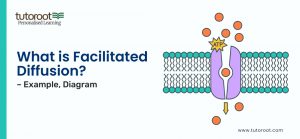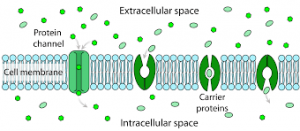What is Facilitated Diffusion? Example, Diagram

Facilitated diffusion is a vital process that helps cells transport essential molecules across their membranes, ensuring proper cellular function and homeostasis. Understanding this process is crucial for students learning about cellular biology, as it bridges the gap between simple diffusion and active transport mechanisms.
Introduction
In cellular biology, diffusion is a fundamental process where molecules move from an area of higher concentration to an area of lower concentration. While simple diffusion occurs directly across the phospholipid bilayer of the cell membrane, facilitated diffusion involves the assistance of specific transport proteins embedded in the membrane. This process is essential for the movement of molecules that cannot freely pass through the lipid bilayer due to their size, charge, or polarity.
What is Facilitated Diffusion?
Facilitated diffusion is a form of passive transport, which means it occurs without the cell needing to use energy. Instead of moving through the lipid bilayer, molecules travel via special protein channels or carriers in the cell membrane. These proteins facilitate the movement of substances like glucose, amino acids, and ions, which are crucial for the cell’s metabolism and function.
The process works by binding the molecule on one side of the membrane, undergoing a conformational change, and then releasing the molecule on the other side. This movement is still driven by the concentration gradient, where molecules move from an area of higher concentration to one of lower concentration.
Importance of Facilitated Diffusion
Facilitated diffusion plays a critical role in maintaining cellular equilibrium and ensuring that cells receive the necessary nutrients and ions to function properly. Without this process, many essential molecules would be unable to enter or exit the cell, leading to a breakdown in cellular operations.
One of the key reasons facilitated diffusion is important is that it enables the selective transport of substances. The transport proteins involved are highly specific, recognizing and binding to particular molecules. This specificity ensures that cells can regulate the internal concentration of various substances, which is crucial for maintaining homeostasis.
For example, glucose, an essential energy source, is transported into cells via glucose transporters through facilitated diffusion. Without this mechanism, cells would be deprived of the glucose necessary for ATP production, ultimately affecting energy levels and cellular functions.
Another critical aspect is the role of facilitated diffusion in the nervous system. Ion channels that facilitate the movement of potassium, sodium, and calcium ions are essential for nerve impulse transmission. These ions move through voltage-gated channels, and their controlled movement is crucial for the generation and propagation of action potentials, which are the signals transmitted along nerves.
Facilitated diffusion is also essential in maintaining osmotic balance within cells. For instance, aquaporins are specialized protein channels that facilitate the movement of water molecules across the cell membrane. This is vital for regulating the water content within cells, preventing them from swelling or shrinking excessively, which could disrupt cellular functions.
Facilitated Diffusion Examples
The below are the examples of facilitated diffusion,
1. Glucose Transporter (GLUT)
Glucose is a primary energy source for cells, and its transport is crucial for cellular respiration. In most cells, glucose enters through a process called facilitated diffusion, mediated by glucose transporter proteins (GLUT). These proteins specifically bind to glucose molecules and transport them into the cell, ensuring a steady supply of glucose for energy production.
The GLUT transporters operate on a concentration gradient, moving glucose from the bloodstream (where it is in higher concentration after a meal) into cells (where it is in lower concentration due to constant utilization). This process is essential in maintaining blood glucose levels and providing energy to cells, especially in organs like the brain and muscles that have high energy demands.
2. Ion Channels (Potassium Channels)
Ion channels are another prime example of facilitated diffusion. Potassium channels, for instance, are integral in maintaining the cell’s resting membrane potential. These channels are selective for potassium ions, allowing them to move out of the cell when the internal concentration is higher than the external.
This movement of potassium ions is crucial for restoring the resting state of a neuron after an action potential. The selective and controlled movement of potassium through these channels ensures that the neuron can reset and be ready for the next signal transmission. This process is vital for the proper functioning of the nervous system and muscle contraction.
Facilitated Diffusion Diagram
Facilitated diffusion can be visualized through diagrams that illustrate the interaction between the transport protein and the molecule being transported. Typically, such diagrams show the cell membrane with embedded protein channels or carriers. A common example is the depiction of a glucose transporter, showing glucose molecules binding to the transporter on one side of the membrane, the protein changing shape, and the glucose being released on the opposite side.
Understanding this diagram is key to grasping the process. The transport protein acts as a selective gateway, with the molecule moving down its concentration gradient without the need for energy input.

Factors Affecting Facilitated Diffusion
Several factors influence the efficiency and rate of facilitated diffusion:
1. Concentration Gradient:
The concentration difference of a molecule across the membrane serves as the main driving force for facilitated diffusion. A steeper gradient results in a faster diffusion rate until equilibrium is reached.
2. Number of Transport Proteins:
The availability of specific transport proteins in the cell membrane can limit or enhance the rate of facilitated diffusion. More protein transport means more molecules can be transported simultaneously.
3. Saturation of Transporters:
Once all transport proteins are occupied, the rate of diffusion reaches a maximum. This is known as saturation, where increasing the concentration of the molecule further does not increase the diffusion rate.
4. Temperature:
Higher temperatures generally increase the kinetic energy of molecules, thus increasing the diffusion rate. However, extreme temperatures can denature the transport proteins, reducing efficiency.
5. Presence of Inhibitors:
Certain molecules can block or inhibit the transport proteins, affecting the facilitated diffusion process. These inhibitors can either compete with the molecule for the transport protein or alter the protein’s structure.
Final Notes
Facilitated diffusion is a critical cellular process that ensures the transport of vital molecules without the need for cellular energy. By understanding its mechanism, importance, and the factors that affect it, students can appreciate how cells maintain their internal environment and function efficiently.
If you found this explanation helpful and want to deepen your understanding of various subjects, explore the Tutoroot Blog for more simplified insights. Tutoroot’s Biology online coaching classes are designed to enhance your learning experience, providing personalised support tailored to your needs. Ready to take the next step? Start with a FREE DEMO session of our online home tuitions and see the difference Tutoroot can make in your education.
FAQs
What is the importance of facilitated diffusion?
Facilitated diffusion is important because it allows cells to transport essential molecules like glucose and ions, which are crucial for energy production and cellular function. It ensures selective transport, helping maintain cellular homeostasis.
Write a few examples for facilitated diffusion.
Examples of facilitated diffusion include the transport of glucose via glucose transporters (GLUT) and the movement of potassium ions through potassium channels in nerve cells.
Define Facilitated diffusion.
Facilitated diffusion is a passive transport process where specific molecules move across the cell membrane via protein channels or carriers, driven by a concentration gradient.
